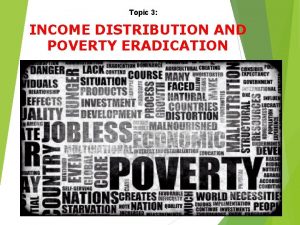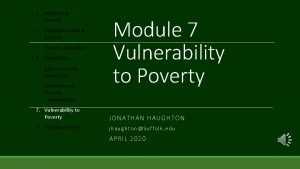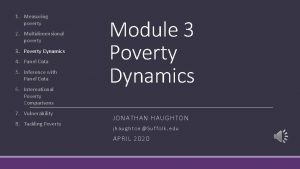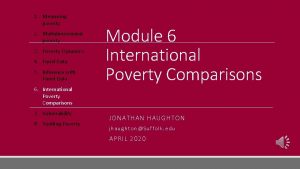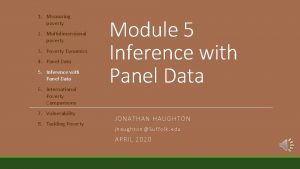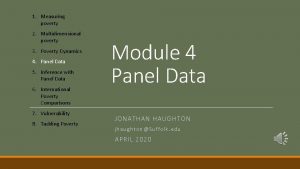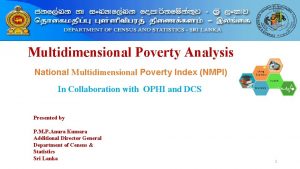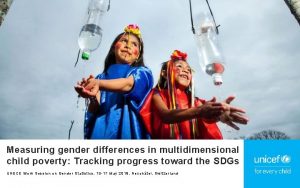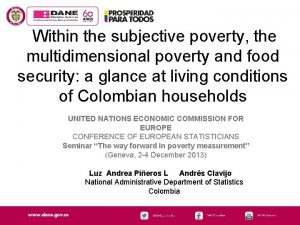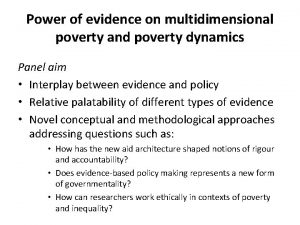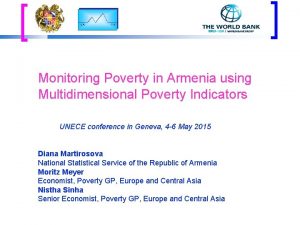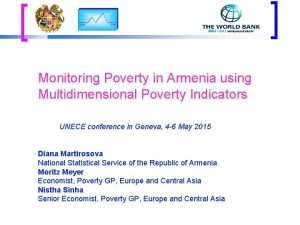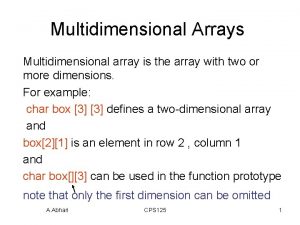1 Measuring poverty 2 Multidimensional poverty 3 Poverty



















- Slides: 19

1. Measuring poverty 2. Multidimensional poverty 3. Poverty Dynamics 4. Panel Data 5. Inference with Panel Data Module 6 International Poverty Comparisons 6. International Poverty Comparisons 7. Vulnerability 8. Tackling Poverty JONATHAN HAUGHTON jhaughton@Suffolk. edu JUNE 2017

Objectives 1. Explain how the World Bank computes world poverty rates, and a. b. c. d. the role played by the initial choice of poverty line the need to use purchasing power parity (PPP) exchange rates the use of domestic CPIs to adjust local-currency poverty lines to the survey year how the poverty rate and level is measured using a Lorenz curve and poverty line. 2. Identify where poverty has fallen most quickly since 1981 3. Evaluate the World Bank approach to measuring world poverty 4. Explain why Dollar and Kraay conclude that growth is good for the poor, and why Ravallion argues that inequality is bad for the poor 5. Define “pro-poor” growth 6. Explain how to decompose changes in poverty into growth and inequality effects 7. Identify the ways in which macroeconomic shocks may affect poverty June 2017 JH: POVERTY MEASUREMENT COURSE 2

Why compare poverty internationally? To target scarce resources To judge progress toward key Millennium Development Goal: halve proportion living on < $1/day between 1990 and 2015. ◦ Now Sustainable Development Goal of zero poverty by 2030! June 2017 JH: POVERTY MEASUREMENT COURSE 3

WB/Chen & Ravallion 1. Pick poverty line ◦ Based on basic needs lines in poorest countries ◦ USD 1. 25/person/day in 2005 prices 2. Use PPP exchange rate: get poverty line in local currency for some specified year 3. Use CPI to create poverty line in nominal local currency, annually since 1981 4. Measure poverty rate from survey data; if necessary estimate using Lorenz curves 5. Interpolate poverty rates for intervening years 6. Aggregate to get world poverty rate June 2017 JH: POVERTY MEASUREMENT COURSE 4

Povcal. Net 2010 version uses data > 850 surveys in 127 LDCs; regularly updated. ◦ http: //iresearch. worldbank. org/Povcal. Net/index. htm Headcount rate has dropped ◦ 52% in 1981, 21% in 2010 (84% to 12% in China) ◦ Change coming most slowly in Africa See table; bubble graph June 2017 JH: POVERTY MEASUREMENT COURSE 5

June 2017 JH: POVERTY MEASUREMENT COURSE 6

Sample graph June 2017 JH: POVERTY MEASUREMENT COURSE 7

Poverty since 1981 by region June 2017 JH: POVERTY MEASUREMENT COURSE 8

Issues What poverty line? ◦ $1. 25 standard based on official poverty line in 15 poorest countries. Too arbitrary? PPP exchange rate conversion ◦ Tries to reflect true prices; but not very accurate, and not based just on goods consumed by poor Internal CPI adjustment ◦ Should reflect “basket” consumed by poor Alternative: Cost-of-basic-needs in each country? (Pogge & Reddy 2003) June 2017 JH: POVERTY MEASUREMENT COURSE 9

Implications: Growth is good for the poor Dollar and Kraay 2002 ◦ 137 countries, 1950 -1999 ◦ 418 episodes (5 -year intervals; measure income of poorest quintile) ◦ Ln(poor) = 1. 07 ln(inc/cap) – 1. 77 R 2 = 0. 88 ◦ i. e. poor keep up with GDP growth in long-run ◦ Δln(poor) = 1. 19 Δln(inc/cap) – 0. 007 R 2 = 0. 49 ◦ i. e. short-term link is weaker; policy can matter ◦ Robust results. Institutional variables don’t help. June 2017 JH: POVERTY MEASUREMENT COURSE 10

“Growth is good” illustrated June 2017 JH: POVERTY MEASUREMENT COURSE 11

Pro-poor growth? Kraay (2004) ◦ Medium run: poverty tracks economic growth ◦ Hard to identify what else helps Two definitions: Growth is pro-poor if: – [Absolute] incomes of the poor are rising Chile, India, Bangladesh, Brazil – [Relative] incomes of poor are growing faster than the population as a whole Ghana, Zambia June 2017 JH: POVERTY MEASUREMENT COURSE 12

Datt and Ravallion (1991) decomposition P*: Poverty in t=1 if no change in distribution P**: Poverty in t=0 if distribution of t=1 held, same mean June 2017 JH: POVERTY MEASUREMENT COURSE 13

Decomposition: comments Even if growth dominates in medium-term, distribution matters in short-term Ravallion: Inequality is bad for the poor ◦ Poverty responds more slowly to growth in high-inequality countries ◦ He finds: no link between economic growth & inequality Holy Grail of Poverty Analysis: Are there policies that can help the poor directly? If so, what? June 2017 JH: POVERTY MEASUREMENT COURSE 14

Growth is good, inequality is bad for the poor June 2017 JH: POVERTY MEASUREMENT COURSE 15

Case: Recession and Poverty in Thailand Links between external shocks and poverty are weak, unclear, country- and time-specific Thailand: exports fell 19%, tourists 14%, GDP 2. 3% due to “great recession” June 2017 JH: POVERTY MEASUREMENT COURSE 16

Expenditure maintained Shock was sharp but short ◦ Recession kept some prices in check ◦ Consumption smoothing ◦ Active government response Losers: Young wage workers in Bangkok June 2017 JH: POVERTY MEASUREMENT COURSE 17

Thai recession: Only Bangkok hurt June 2017 JH: POVERTY MEASUREMENT COURSE 18

Readings Haughton & Khandker, chapter 10 Chen and Ravallion (2008) • ◦ Chen, Shaohua, and Martin Ravallion. 2008. The Developing World Is Poorer Than We Thought, But No Less Successful in the Fight against Poverty. Policy Research Working Paper No. 4703, World Bank, Washington, DC. Povcal. Net: http: //iresearch. worldbank. org/Povcal. Net/index. htm Haughton (2012): Bubble Rap ◦ Jonathan Haughton. 2012. Bubble Rap: Visualizing Poverty Dynamics, Case Studies in Business, Industrial, and Government Statistics. Data file at http: //web. cas. suffolk. edu/faculty/jhaughton/Bubbles. GDPp 125 r 2017. xlsm Dollar and Kraay (2002) ◦ David Dollar & Aart Kraay. Growth is Good for the Poor, Journal of Economic Growth, 7(3): 195 -225. Haughton & Khandker (2012) on Thailand ◦ Jonathan Haughton and Shahidur Khandker. 2013. “The Surprising Effects of the Great Recession: Losers and Winners in Thailand in 2009 -2009”, under consideration by World Development. June 2017 JH: POVERTY MEASUREMENT COURSE 19
 Distinguish between absolute and relative poverty
Distinguish between absolute and relative poverty Proxscal
Proxscal Distance matrix example
Distance matrix example Multidimensional model of leadership
Multidimensional model of leadership Multidimensional expressions
Multidimensional expressions Multidimensional talent
Multidimensional talent Emergent leaders in sport examples
Emergent leaders in sport examples Arrays in pascal
Arrays in pascal Turing machine
Turing machine Ssas multidimensional vs tabular
Ssas multidimensional vs tabular Multidimensional gradient
Multidimensional gradient Mining complex types of data
Mining complex types of data Multidimensional turing machine
Multidimensional turing machine Index
Index What is a multidimensional database
What is a multidimensional database Multidimensional reporting
Multidimensional reporting Multidimensional scaling - ppt
Multidimensional scaling - ppt Multidimensional or hypervolume niche
Multidimensional or hypervolume niche Multidimensional space in data mining
Multidimensional space in data mining Multidimensional expressions
Multidimensional expressions
